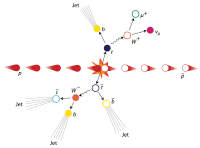Top quark

A collision event involving top quarks
|
|
| Composition | Elementary particle |
|---|---|
| Statistics | Fermionic |
| Generation | Third |
| Interactions | Strong, Weak, Electromagnetic force, Gravity |
| Symbol | t |
| Antiparticle | Top antiquark ( t ) |
| Theorized | Makoto Kobayashi and Toshihide Maskawa (1973) |
| Discovered | CDF and DØ collaborations (1995) |
| Mass | 172.44 ± 0.13 (stat) ± 0.47 (syst)GeV/c2 |
| Decays into |
bottom quark (99.8%) strange quark (0.17%) down quark (0.007%) |
| Electric charge | +2/3 e |
| Color charge | Yes |
| Spin | 1/2 |
| Topness | 1 |
| Weak isospin | LH: +1/2, RH: 0 |
| Weak hypercharge | LH: +1/3, RH: +4/3 |
The top quark, also known as the t quark (symbol: t) or truth quark, is the most massive of all observed elementary particles. Like all quarks, the top quark is an elementary fermion with spin 1/2, and experiences all four fundamental interactions: gravitation, electromagnetism, weak interactions, and strong interactions. It has an electric charge of +2/3 e, It has a large mass of 172.44 ± 0.13 (stat) ± 0.47 (syst)GeV/c2, which is about the same mass as an atom of tungsten. The antiparticle of the top quark is the top antiquark (symbol: t, sometimes called antitop quark or simply antitop), which differs from it only in that some of its properties have equal magnitude but opposite sign.
The top quark interacts primarily by the strong interaction, but can only decay through the weak force. It decays to a W boson and either a bottom quark (most frequently), a strange quark, or, on the rarest of occasions, a down quark. The Standard Model predicts its mean lifetime to be roughly 5×10−25 s. This is about a twentieth of the timescale for strong interactions, and therefore it does not form hadrons, giving physicists a unique opportunity to study a "bare" quark (all other quarks hadronize, meaning that they combine with other quarks to form hadrons, and can only be observed as such). Because it is so massive, the properties of the top quark allow predictions to be made of the mass of the Higgs boson under certain extensions of the Standard Model (see Mass and coupling to the Higgs boson below). As such, it is extensively studied as a means to discriminate between competing theories.
...
Wikipedia
